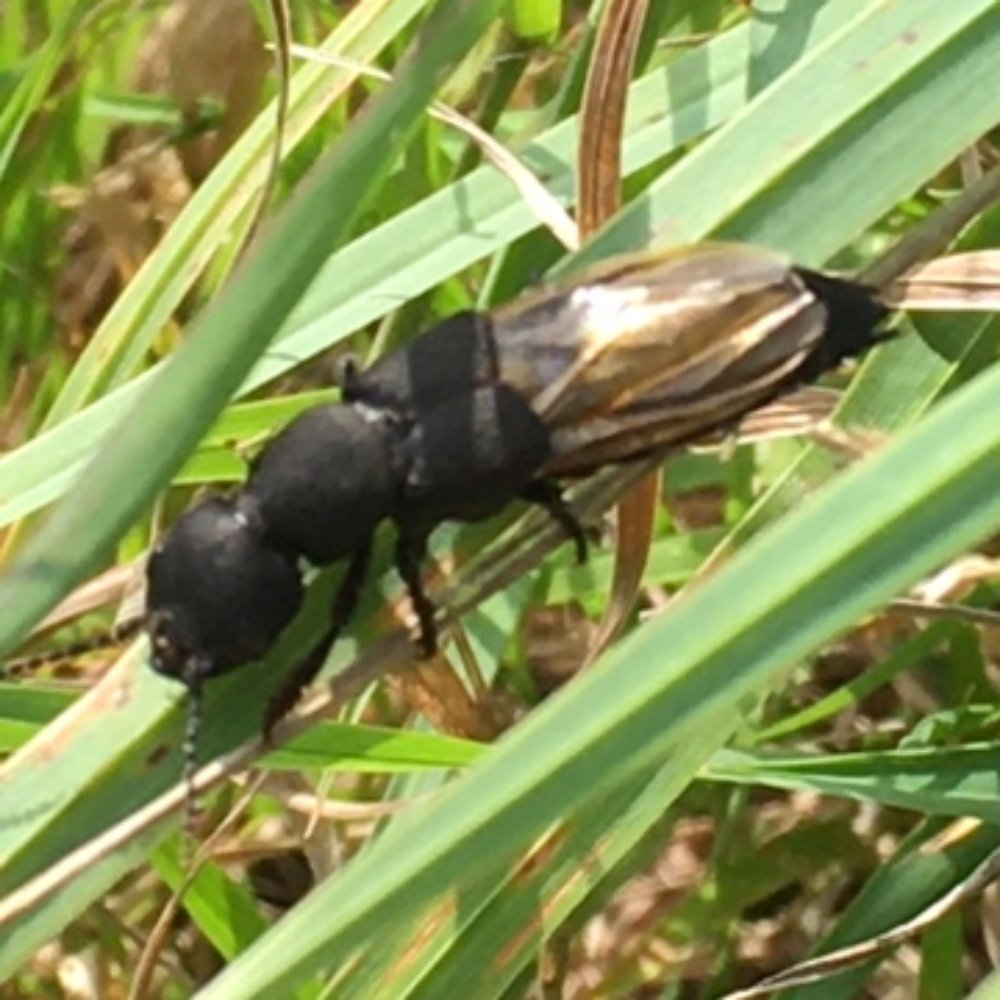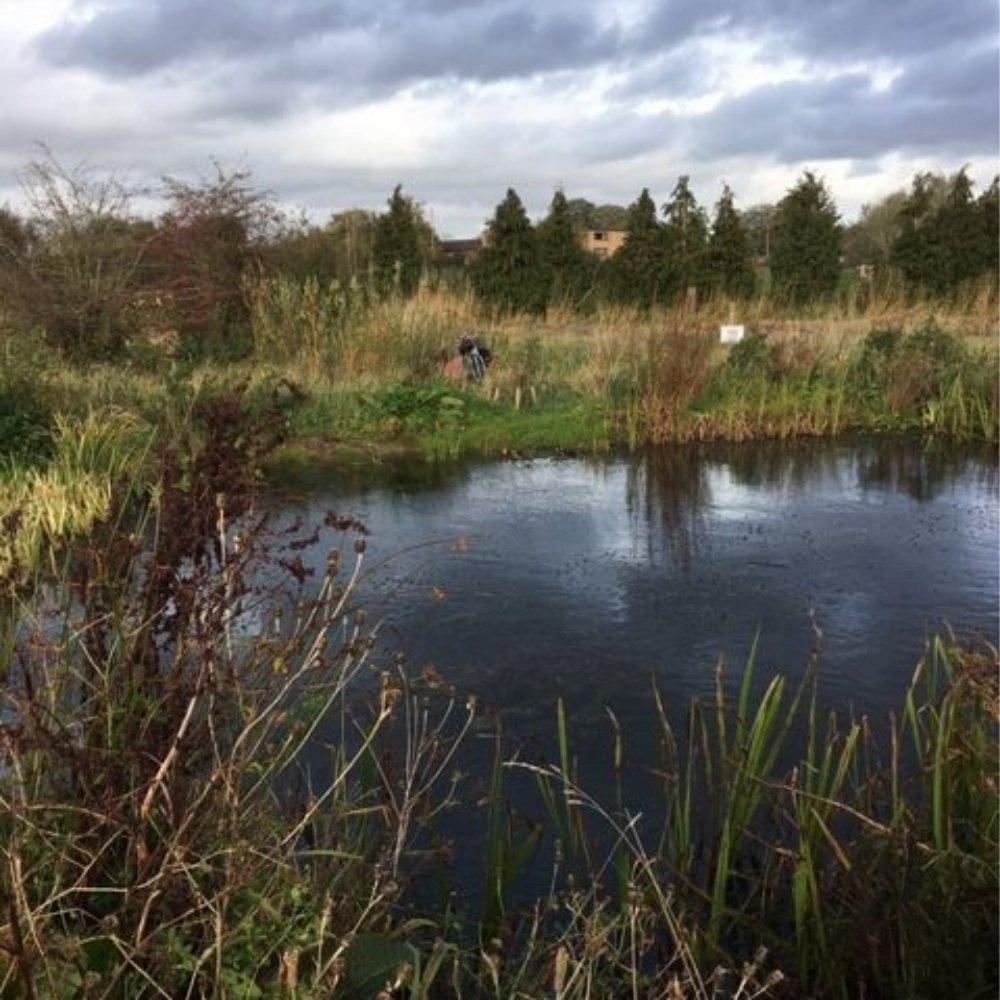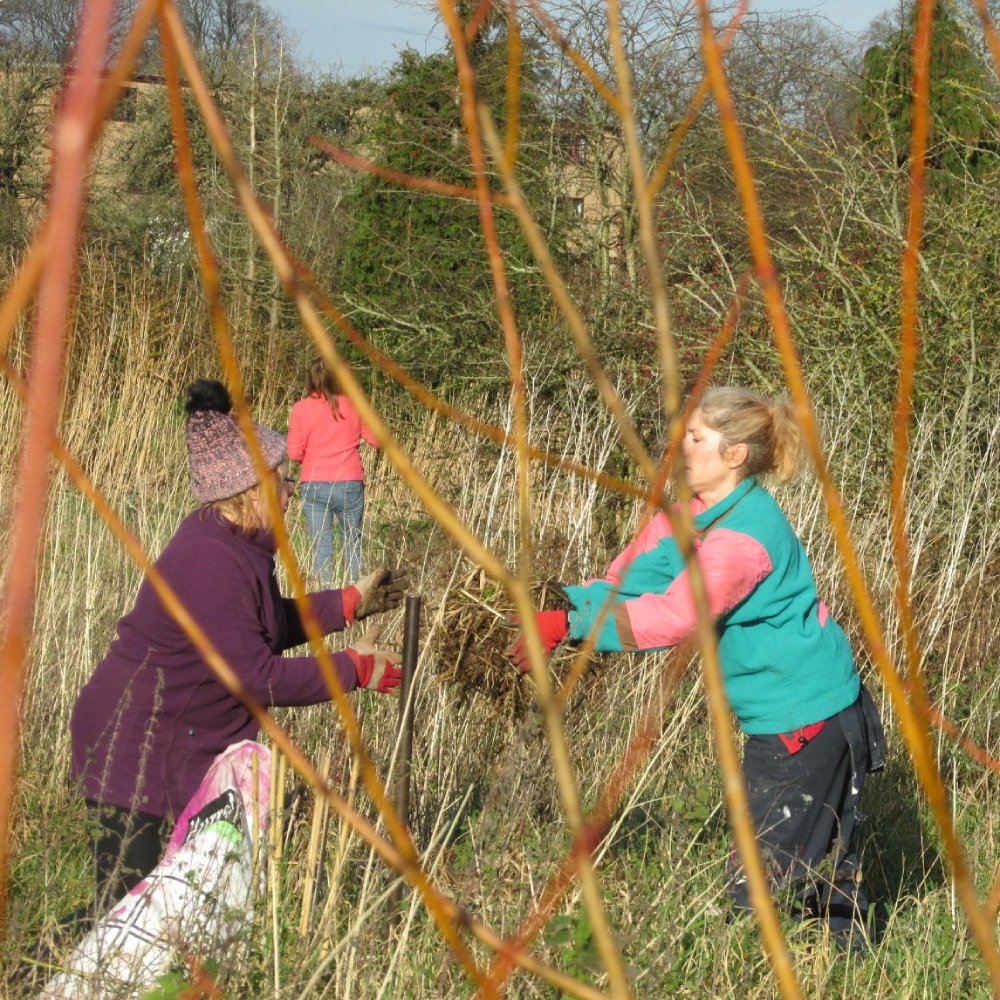Sarah’s Field and Canon Park sports field, Berkeley
Stroud Valleys Project began work on the site with a team of volunteers in 2018 and in this short time have transformed a damp field into a thriving area for community and wildlife, with ponds, an orchard, picnic areas and pathways.
Sarah’s Field is named after the girl who kept her horses here in the early 1900s. Her granddaughter, Pamela Thorpe, bequeathed the field to Berkeley Town Council as a green community space with a water meadow. Gradually, the field has become a place! Volunteers have met regularly to manage, mow and create habitats. Over time, paths were mown, a lot of digging was done, gates were put in place, a bog was made.
Spring 2024: Soggy work at Sarah’s Field by Fred Miller
The winter was so wet that you needed to be amphibious! But luckily there are animals who thrive in this: the shallow pond/marsh had copious tadpoles wriggling by March. Newts have been seen in the deeper ponds, and there will be a newt survey here in May, with our own Richard and John, to assess the species present and their numbers.
Willow wonders
This winter, the team at Sarah’s Field gave the Osier Willows a good prune back which looks rather drastic, but, of course, the willow will regrow quite happily. They then replanted some of these stems to create new growth. The plan is for this to be woven and bent into a living, chaotic jungle of tunnels and dens for young and old to explore!
Apples to apples
We grafted (attached) some apple stems onto root stock with a new tool: grafting pliers. Grafting like this gives you a nice neat fit between the two sections of wood: the scion (the fruit you want) and the root stock (the vigour of root you want). We chose the variety of apple called Arlingham Schoolboys to graft, as we particularly like its juicy sweetness, but we also hope to propagate by ‘air layering’ – an almost magical-sounding method – to create new apple trees!
Emergency hedge repair
There was a gap in the hedge that needed blocking; the council had decided that this informal entrance to the site was not safe. And, being SVP, we took this as an excuse to plant more trees! We thickened up the hedge with hawthorn and field maple; the result will be a wider hedge.
Autumn 2023: Sarah’s Field and Canon Park, Berkeley by Fred Miller
One of our aims this year on these sites was to increase the abundance and variety of wildlowers.
Our team has dug new areas and sowed them with all sorts of annuals and perennials. A good initial flush of flowers was achieved this summer, especially annuals, such as cornflower.
The next step is to plant wild flower plugs of perennials such as Knapweed, Burnet and Sneezewort!
Careful mowing of these areas will be needed to suppress the grass and nettles around the new plants, as well as weeding out bindweed.
The supply of these wild flower plugs by Slimbridge Wildfowl and Wetlands Trust is much appreciated.
An apple-pressing day was held in October. Delicious juice was made with apples from Sarah’s Field and the surrounding area.
The best juice is made from varieties such as russets.
Spring 2023: Tree Day joy by Fred Miller
The Sarah’s Field community Tree Day was held on a misty dank January day.
However, it was a bright success! Many thanks to the stalwart volunteers who heeled in the trees, parcelled up the tree orders, and did all the heavy lifting. Also, thanks to the local Brownies and Rainbows who planted three new apples and then sang a Wassail song to bring good fruit next year!
The last chant of the traditional Wassail goes: “Hats full, caps full, three bushel bags full, and one little heap just under the stairs” (why under the stairs, I do not know!).
On this day and in the following weeks, we supplied 200 native trees (10 different species) to landowners and gardeners in the area, which included residents of nearby new-build housing.
We also found homes for 25 Gloucestershire apple varieties. These all proved popular and people seemed happy with their trees, tree guards and advice on tree care.
Future plans include a wildflower verge because the town council would like more flowers for insects – excellent!
We can help!
Winter 2022/3 update - a pressing engagement by Fred Miller
An apple pressing day was held at Sarah’s Field on Saturday 1 October, with the Girl Guides and Rainbows. Many people came along, including volunteer and long-time supporter Kathy McNicholas and her family (pictured here). It was a joy to see the face of Kathy’s mother Janet light up!
The apples are washed, then chopped into halves or quarters. Bad bits are removed at this stage, such as any rot or caterpillar poo (known as frass – usually from the Codling Moth larva). They are then mashed by turning the handle of the hand-powered rotary mill, called the scratter, before the resulting pulp is put into the press to release the juice. To enhance safety, the press was fixed down with strong screws on a wooden base on palettes. Young people can operate the press by standing on this platform. The scratter is also fixed down to a frame, to make it safer, and a big wooden spoon can be used to push the apples into it.
The grassland at Sarah’s Field is maintained by scything different areas each year, to limit the bramble and blackthorn. Wildflowers are being encouraged by scraping the ground to make new patches of bare soil for seeds to grow. Some of the hay from Capel’s Mill was brought and spread in order to gain Wild Carrot, Knapweed, and Ladies’ Bedstraw. Also to be sown are Meadow Buttercup and Meadowsweet; and Reeds, by digging and replanting their roots in winter time (this is very hard work as it is the toughest plant ever!).
Local wildlife recorder Fred Holpin continues to monitor the comings and goings on the site, from birds to butterflies. The arrival times of different species of migratory birds and insects are of course changing with the climate, and his information is vital for conservation.
Earlier progress
It now has pathways, fruit trees, entrance gates, picnic tables, a bog and two ponds, and benches to sit on and contemplate the view.
Fruit and hawthorn were pruned over the winter and there is now a new tree nursery to bring on a range of species such as alder, buckthorn and apple rootstock which will enable fruit tree grafting.
Digging planting holes
Berkeley Town Council has also now asked us to help at their sports’ field, Canon Park. In December, we planted 55 trees and shrubs to complement a new children’s play area, which is acting as screening from housing and also provides bird and insect habitat.
In April, jute mats were added to control grass growth, around the base of each tree. They were fixed with the bamboo pegs provided with these mats: all bio-degradable! We have thought we would like in the future to make our own pegs split from local wood.
Bird boxes have also been put up on surrounding large trees, and bat boxes will be added soon.
Stroud Valleys Project friend and willow expert, Norah Kennedy
Other recent installations have included a willow bower and a bench for local people to enjoy.
On the Sarah’s Field site are toads, voles, fox and badger paths, resident starlings and sparrows. At the edges is blackthorn scrub full of sparrows and blue tits; we have added some different tree species such as alder, willow, spindle and dog rose to create diversity.
Fourteen Gloucestershire apple varieties are growing at here, including Nine Square, Longney Russet, the rare Wellstead Pippin, Jackets and Waistcoats, Kingston Black, Elmore Pippin, Ampney Red and others besides.
The extraordinary history of the apple has been revealed in recent research on its DNA. The genetic ancestry of our familiar apple is partly (46%) from the wild apple of the Tian Shan mountains (in modern Kazakhstan) and partly (33%) from the European crab apple. It is thought it was partly spread, sweetened and also enlarged by animals.
As you bite into an apple it is fun to think that you are connected to a bear’s taste preferences thousands of years ago via its stomach and droppings in the middle of Asia….
Some history of the Sarah’s Field project
The first task was planting 20 fruit trees, with a focus on rare and local Gloucestershire apple varieties, such as ‘Berkeley Pippin’, ‘Arlingham Schoolboys’ and ‘Jackets and Waistcoats’.
A pond-dipping platform has been completed, stepping stones put in place to access the pond edges, and wildflower seeds sown to landscape this new wetland area. Great diving beetle and dragonfly nymph were spotted, and birds are visiting to drink and wash: a little egret, heron and mallards have all tested the ponds. We hope it is to their satisfaction.
In the rhine (ditch) which borders the field, otter and muntjac deer footprints have been seen. There are vole holes in the tussocks of grass.
One spring day the following were spotted: a sparrow hawk, four butterfly species, starlings, sparrows, and ravens. It was sunny and warm. Local resident, Fred Holpin, is keeping a record of wildlife spotted on the site.
Drought management
The very hot periods in the spring and summer seasons can cause water loss to the ponds on this site. This has sometimes led to concern, particularly as the field was so well-used as an educational and recreational space during the lockdown period. Many families were invested in the wellbeing of newts, nymphs and diving beetles. Eventually, success was achieved with a water pump, but a longer-term solution was sought with the backing of the town council, to automatically pump ground water into the ponds using an agricultural solar-powered pump.
In a way, by replacing the water that the modern drainage system is removing, we are re-wetting the habitat – surely a good thing!
We hope Sarah would be pleased with this work in her field.
Field Location
You will find a map here: Sarah's Field location
Sarah’s Field is in the middle of the map, the one to the left of the road called James Orchard and beside Lynch Road.

















